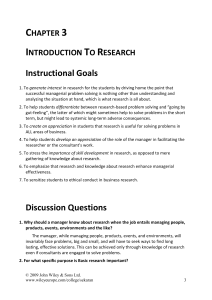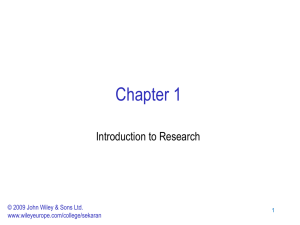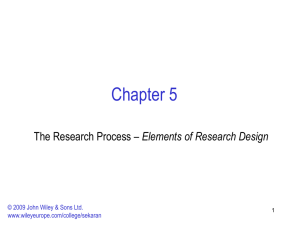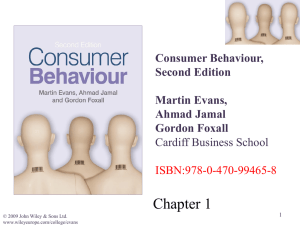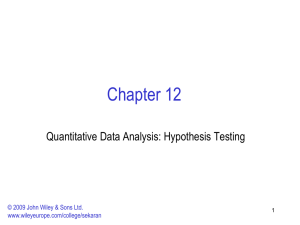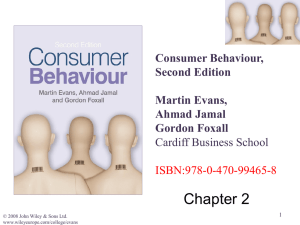CH08
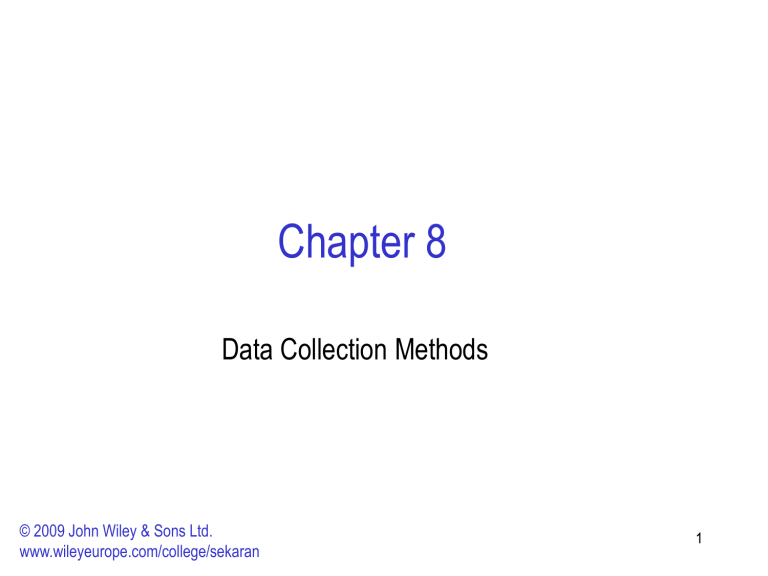
Chapter 8
Data Collection Methods
© 2009 John Wiley & Sons Ltd.
www.wileyeurope.com/college/sekaran
11
Sources of Data
Primary data: information obtained firsthand by the researcher on the variables of interest for the specific purpose of the study.
Examples: individuals, focus groups, panels
Secondary data: information gathered from sources already existing.
Examples: company records or archives, government publications, industry analyses offered by the media, web sites, the Internet, and so on.
© 2009 John Wiley & Sons Ltd.
www.wileyeurope.com/college/sekaran
2
Personal Interview
Advantages
– Can clarify doubts about questionnaire
– Can pick up non-verbal cues
– Relatively high response/cooperation
– Special visual aids and scoring devises can be used
Disadvantages
– High costs and time intensive
– Geographical limitations
– Response bias / Confidentiality difficult to be assured
– Some respondents are unwilling to talk to strangers
– Trained interviewers
© 2009 John Wiley & Sons Ltd.
www.wileyeurope.com/college/sekaran
3
Telephone Interview
Advantages
– Discomfort of face to face is avoided
– Faster / Number of calls per day could be high
– Lower cost
Disadvantages
– Interview length must be limited
– Low response rate
– No facial expressions
© 2009 John Wiley & Sons Ltd.
www.wileyeurope.com/college/sekaran
4
Self-administered
Advantages
– Lowest cost option
– Expanded geographical coverage
– Requires minimal staff
– Perceived as more anonymous
Disadvantages
– Low response rate in some modes
– No interviewer intervention possible for clarification
– Cannot be too long or complex
– Incomplete surveys
© 2009 John Wiley & Sons Ltd.
www.wileyeurope.com/college/sekaran
5
Principles of Questionnaire Design.
© 2009 John Wiley & Sons Ltd.
www.wileyeurope.com/college/sekaran
6
Questionnaire Design
Definition
A questionnaire is a pre-formulated, written set of questions to which the respondent records his answers
Steps
1.
Determine the content of the questionnaire
2.
Determine the form of response
3.
Determine the wording of the questions
4.
Determine the question sequence
5.
Write cover letter
© 2009 John Wiley & Sons Ltd.
www.wileyeurope.com/college/sekaran
7
1. Questionnaire content
Framework
Need information for all constructs in framework
Measurement: Operationalizing
– Objective construct:
• 1 element/items
=> 1 question
– Subjective construct:
• multiple elements/items
=> multiple questions
© 2009 John Wiley & Sons Ltd.
www.wileyeurope.com/college/sekaran
8
2. Response format
Closed vs. Open-ended questions
– Closed questions
• Helps respondents to make quick decisions
• Helps researchers to code
– Open-ended question
• First: unbiased point of view
• Final: additional insights
• Complementary to closed question: for interpretation purpose
Cfr. Measurement: Response scales
© 2009 John Wiley & Sons Ltd.
www.wileyeurope.com/college/sekaran
9
3. Question Wording
Avoid double-barreled questions
Avoid ambiguous questions and words
Use of ordinary words
Avoid leading or biasing questions
Social desirability
Avoid recall depended questions
© 2009 John Wiley & Sons Ltd.
www.wileyeurope.com/college/sekaran
10
Question Wording
Use positive and negative statements
– Dresdner delivers high quality banking service
Dresdner has poor customer operational support
– Avoid double negatives
Limit the length of the questions
Rules of thumb:
– < 20 words
– < one full line in print
© 2009 John Wiley & Sons Ltd.
www.wileyeurope.com/college/sekaran
11
4. Question Sequence
© 2009 John Wiley & Sons Ltd.
Personal and sensitive data at the end www.wileyeurope.com/college/sekaran
12
5. Cover Letter
The cover letter is the introductory page of the questionnaire
It includes:
– Identification of the researcher
– Motivation for respondents to fill it in
– Confidentiality
– Thanking of the respondent
© 2009 John Wiley & Sons Ltd.
www.wileyeurope.com/college/sekaran
13
Structured Observations
Recording prespecified behavioral patterns of people, objects and events in a systematic manner.
Quantitative in nature
Different types
– Personal observation
(e.g., mystery shopper, pantry audit)
– Electronic observation
(e.g., scanner data, people meter, eye tracking)
© 2009 John Wiley & Sons Ltd.
www.wileyeurope.com/college/sekaran
14
